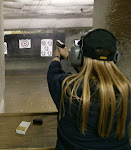From a Fellow Firearms Enthusiast:
The issue is not whether Mr. Baldwin is a good person or a bad one. Neither that nor his politics matter. The relevant fact is that he obviously violated three basic safe gun handling rules:
1. Every gun must be treated as loaded. That has to be the default assumption until the person handling it personally takes every one of the multiple steps necessary to ascertain and confirm that it is not. Being told by any other person or persons that a firearm is unloaded won't cut it or excuse a violation of this rule.
2. No gun ever should be pointed at any portion of one's own body or at any other person who does not pose an immediate dangerous threat.
3. No gun holder ever should place a finger inside the trigger guard unless and until the gun is aimed at a target at which the gun holder has decided to
shoot.
Anyone who picks up a gun and fails to comply with each of these fundamental common sense rules must be held accountable -- legally, financially, and morally -- for the consequences of any such failure . . . and this is particularly true when all three rules are violated with fatal consequences.









Much has been made of the "movie' setting and the failure of the "green" armorer. Semi automatic firearms with "closed" actions can be tricky but if a revolver is called "cold" (no ammunition of any kind), it is trivally easy to look at the firearm. If you see "brass", it isn't "cold". Hand the "prop" (i.e. property, of the "theater) back to the armorer with insults loud enough for the Producer to hear. Even after such an inspection, the rules of safe firearm handling apply.
ReplyDeleteI find it "interesting" that Baldwin's "at the camera" shot missed the camera shield and hit and killed the "uppity" woman who had been grieving him about set safety. Seems like a "strange" accident. Baldwin looked upset afterwards, but after all, he is something of an "actor".
I despise Alec Baldwin for his politics, but this is going too far. I've seen hundreds of movies where actors point and fire guns at the camera or other actors. It wouldn't be very convincing without the flash-bang, would it. So what is the actor's responsibility, whether it's Alec Baldwin or Clint Eastwood?
ReplyDeleteI will agree that rule 1 may apply. Apply the same rule to operating your automobile. You take it for inspection and the mechanic tells you the brake lines are in good condition. Is it your responsibility to inspect those brake lines every time you decide to drive your car? A failed brake line can cause an accident leading to injury or death. Where does the mechanic's responsibility end and yours begin? You can make a similar case for flying an airplane. Is it the pilot's responsibility to check the turbine blades before flying, or does that fall on the mechanic?
As for rules 2 and 3, that is absurd in the context of making a movie. The gun is supposed to be loaded, with blanks of course. It is supposed to be pointed at some target and it is supposed to be discharged. Take the hundreds of movies made using guns and have them do nothing when the trigger is pulled. How would that fly with audiences?
My problem with Baldwin and a lot of anti-gun actors is accepting roles in movies where justice or self-defense is delivered at the end of gun barrel. They will glorify the gun user, as long as it isn't you defending yourself or stopping a crime.